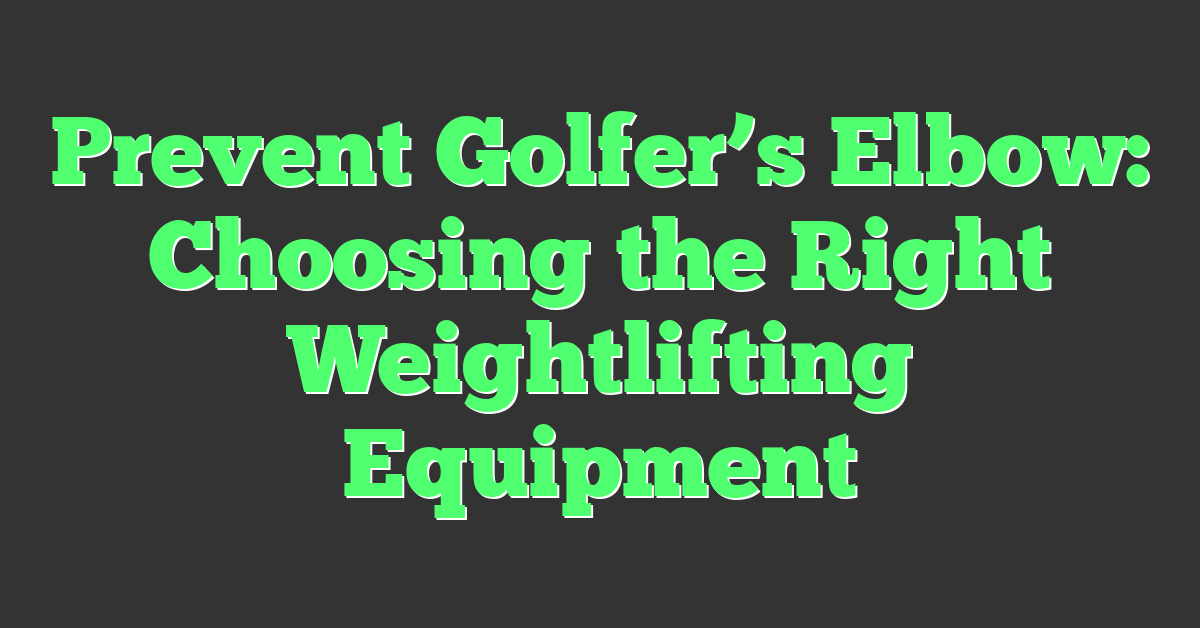
Are you an avid weightlifter who also enjoys playing golf? If so, you may have experienced the frustrating pain of golfer’s elbow. This common condition, medically known as medial epicondylitis, can be a real setback for your fitness routine and golf game. But fear not! In this article, we’ll share some valuable tips and techniques to help you prevent golfer’s elbow when lifting weights. With these simple adjustments, you can continue pursuing your fitness goals without the nagging pain in your elbow.
When it comes to preventing golfer’s elbow, proper form is key. Many weightlifters unknowingly put excessive strain on their elbows by using incorrect techniques. By focusing on maintaining a neutral wrist position and avoiding excessive bending or twisting of the elbow, you can significantly reduce the risk of developing golfer’s elbow. In this article, we’ll dive deeper into the correct form and provide step-by-step instructions to ensure you’re lifting weights in a way that protects your elbows.
In addition to proper form, it’s crucial to gradually increase the intensity and duration of your weightlifting sessions. Overloading your muscles and tendons too quickly can lead to overuse injuries, including golfer’s elbow. We’ll discuss the importance of progressive overload and offer practical advice on how to gradually increase your weights and repetitions without putting unnecessary strain on your elbows. By following these guidelines, you can continue challenging yourself while minimizing the risk of developing golfer’s elbow.
What is Golfer’s Elbow?
As a dedicated golfer, you’re probably familiar with the term “golfer’s elbow.” But do you really know what it is and how it can affect your game? Golfer’s elbow, also known as medial epicondylitis, is a common condition that affects the tendons on the inside of your elbow. It’s called golfer’s elbow because it’s often caused by repetitive motions, such as swinging a golf club, that put strain on these tendons.
When you swing a golf club, your wrist and forearm muscles contract, causing stress on the tendons that attach to the inside of your elbow. Over time, this repetitive motion can lead to inflammation and pain. Golfer’s elbow can be a real game-changer, affecting your swing, your accuracy, and even your ability to enjoy a round of golf.
Symptoms of golfer’s elbow include pain and tenderness on the inside of your elbow, weakness in your grip, and difficulty performing activities that require gripping or lifting. It’s important to address these symptoms early on to prevent them from getting worse and interfering with your golf game.
So, how can you prevent golfer’s elbow when lifting weights? By following a few simple tips, you can reduce your risk of developing this frustrating condition and keep swinging with confidence.
Causes of Golfer’s Elbow
As an experienced golfer, you know that golf is a sport that requires precision and finesse. However, it also involves repetitive motions that can put strain on your tendons, leading to golfer’s elbow. Understanding the causes of this condition is crucial in preventing it and improving your game.
Repetitive Motion: The primary cause of golfer’s elbow is the repetitive motion of swinging the golf club. Every time you swing, the tendons on the inside of your elbow are put under stress. Over time, this repetitive strain can lead to inflammation and pain.
Incorrect Technique: Another factor that contributes to golfer’s elbow is using incorrect technique during your swings. When you don’t have the proper form, you put excessive stress on your tendons, increasing the risk of injury. It’s essential to work with a golf instructor to ensure that you have the correct technique and posture.
Overuse and Overtraining: Playing golf too frequently or overtraining can also lead to golfer’s elbow. Your body needs time to rest and recover between sessions. Pushing yourself too hard without giving your tendons time to heal can result in injury. Be mindful of your training schedule and allow for adequate rest days.
Improper Warm-up and Cool-down: Failing to warm up properly before a round of golf or neglecting to cool down afterward can contribute to golfer’s elbow. A thorough warm-up increases blood flow to the muscles and prepares them for the demands of the game. Similarly, a cool-down helps flush out any lactic acid buildup and promotes recovery.
By understanding the causes of golfer’s elbow, you can take proactive steps to prevent it. Focus on using proper technique, allowing for adequate rest and recovery, and incorporating warm-up and cool-down exercises into your routine. With these preventative measures in place, you’ll be able to enjoy the game you love while reducing the risk of golfer’s elbow.
Understanding the Mechanics of Golfer’s Elbow
As a dedicated golfer, you understand the importance of maintaining a strong and healthy body to improve your game and shoot lower scores. One common ailment that can hinder your progress is golfer’s elbow, also known as medial epicondylitis. By understanding the mechanics of this condition, you can take proactive steps to prevent it when lifting weights and keep yourself in top form on the golf course.
Golfer’s elbow occurs when the tendons on the inside of your elbow become inflamed or damaged. This is often caused by repetitive motions, such as swinging a golf club or lifting weights improperly. When you lift weights, especially with incorrect form or excessive bending and twisting of the elbow, you put strain on these tendons, leading to pain, tenderness, and weakness in your grip.
To prevent golfer’s elbow when lifting weights, it is crucial to focus on maintaining proper form and technique. Start by ensuring that you have a solid foundation and grip on the weights. Keep your wrists straight and avoid excessive bending or twisting of the elbow during exercises. Gradually increase the intensity and duration of your weightlifting sessions to allow your tendons and muscles to adapt and strengthen over time.
In addition to proper form, it is essential to incorporate a thorough warm-up and cool-down routine into your weightlifting sessions. By warming up your muscles and tendons before starting your workout, you can increase blood flow and flexibility, reducing the risk of injury. Similarly, cooling down after your workout with stretches and gentle exercises can help prevent stiffness and promote recovery.
Symptoms of Golfer’s Elbow
If you’re an avid golfer like myself, you know how important it is to keep your body in top shape to improve your game and shoot those lower scores. Unfortunately, one condition that can hinder your progress is golfer’s elbow, also known as medial epicondylitis. This common injury affects the tendons on the inside of your elbow and can be quite a nuisance if left untreated. So let’s take a closer look at the symptoms of golfer’s elbow to help you recognize it early and prevent it from affecting your game.
1. Pain and Tenderness: One of the most obvious signs of golfer’s elbow is pain and tenderness on the inside of your elbow. You may experience a dull, achy sensation that can worsen with certain movements, such as gripping a golf club or lifting weights. The pain may radiate down your forearm, making it uncomfortable to perform everyday activities.

2. Weakness in Grip: Another symptom to watch out for is weakness in your grip. You may notice difficulty in holding onto the club or weights, as well as a decrease in your overall grip strength. This can significantly impact your swing and power, leading to inconsistent shots and decreased performance on the course.
3. Difficulty with Gripping and Lifting: Golfer’s elbow can also make it challenging to perform activities that require gripping or lifting. Everyday tasks like opening jars, carrying groceries, or even shaking hands may become painful and uncomfortable. This can be frustrating and limit your ability to fully enjoy your golfing experience.
It’s important to note that these symptoms may vary in severity and can worsen over time if not addressed properly. If you experience any of these symptoms, it’s crucial to take action and seek appropriate treatment to prevent further damage.
Without a conclusion paragraph or sentence, let’s continue exploring how we can prevent golfer’s elbow when lifting weights.
How to Prevent Golfer’s Elbow When Lifting Weights
As a low handicap golfer who has played my whole life, I understand the importance of staying fit and strong to improve your game. However, lifting weights improperly can lead to a common condition called golfer’s elbow, which can hinder your performance on the course. Here are some tips to help you prevent golfer’s elbow when lifting weights:

1. Focus on Proper Form: One of the most crucial aspects of preventing golfer’s elbow is maintaining proper form while lifting weights. Make sure you have a good understanding of the correct technique for each exercise and pay attention to your body’s alignment. Avoid any excessive twisting or bending of the elbow that could put unnecessary strain on the tendons.
2. Gradually Increase Intensity: It’s essential to gradually increase the intensity and duration of your weightlifting sessions. Pushing yourself too hard, too quickly can overload the tendons and increase the risk of developing golfer’s elbow. Start with lighter weights and gradually progress as your strength improves.
3. Incorporate a Thorough Warm-Up and Cool-Down Routine: Before you start your weightlifting session, take the time to warm up your muscles and tendons. Engage in some dynamic stretches and light cardiovascular exercises to increase blood flow to the area. Similarly, after your workout, perform static stretches to cool down and promote proper recovery.
4. Listen to Your Body: Pay attention to any warning signs your body may be giving you. If you start to feel discomfort or pain in your elbow while lifting weights, take a break and allow your body to recover. Ignoring these warning signs can lead to more serious injury and longer recovery times.
5. Seek Professional Guidance: If you’re new to weightlifting or unsure about your form, consider seeking guidance from a professional trainer or coach. They can help you establish a safe and effective weightlifting routine tailored to your specific needs and goals.

Proper Form and Technique
When it comes to preventing golfer’s elbow while lifting weights, proper form and technique are crucial. Just as in golf, where correct mechanics can make all the difference in your swing, using the right form when lifting weights can help protect your elbows and minimize the risk of injury. Here are a few tips to keep in mind:
- Maintain a neutral wrist position: When performing weightlifting exercises, such as curls or presses, make sure to keep your wrists in a neutral position. Avoid excessive flexion or extension, as this can put unnecessary strain on the tendons in your elbow.
- Engage your core: A strong core is essential for maintaining stability and distributing the load evenly throughout your body. By engaging your core muscles during weightlifting, you can reduce the strain on your elbows and prevent golfer’s elbow.
- Use proper grip: Just like gripping a golf club, having the correct grip on weights is essential. Avoid using a death grip, which can increase tension in your forearms and put stress on your elbows. Instead, hold the weights with a firm, but relaxed grip.
- Start with lighter weights: If you’re new to weightlifting or are recovering from golfer’s elbow, it’s important to start with lighter weights and gradually increase the intensity. This allows your tendons and muscles to adapt to the load without overstraining them.
- Avoid excessive bending and twisting: When performing exercises that involve bending or twisting of the elbow, such as bicep curls or tricep extensions, be mindful of your range of motion. Avoid going beyond what feels comfortable and listen to your body’s cues.
Warming Up and Stretching
As a low handicap golfer who has played your whole life, you understand the importance of warming up and stretching before hitting the golf course. Just like in golf, warming up and stretching are also crucial when it comes to preventing golfer’s elbow when lifting weights. Here are some tips to help you incorporate a proper warm-up and stretching routine into your weightlifting sessions:
- Dynamic Warm-Up: Before you even pick up a weight, it’s essential to get your muscles and joints warmed up. Incorporate dynamic movements such as arm circles, shoulder rotations, and wrist exercises to increase blood flow and flexibility in the muscles surrounding your elbow.
- Forearm Stretches: Pay special attention to stretching your forearms, as these are the muscles directly involved in gripping the weight. Perform exercises like wrist flexor and extensor stretches, where you extend your arm forward and gently pull your fingers back or push them forward to stretch the muscles in your forearm.
- Shoulder and Upper Back Stretches: A strong and stable upper back and shoulders are crucial for maintaining proper form and preventing unnecessary strain on your elbows. Incorporate exercises like shoulder rolls, arm swings, and upper back stretches to loosen up these areas before your weightlifting session.
- Gentle Wrist Exercises: As a golfer, you know the importance of maintaining a neutral wrist position. The same applies to weightlifting. Perform exercises like wrist rolls and wrist circles to improve wrist mobility and strengthen the muscles in your forearms.
Remember, the goal of warming up and stretching is to prepare your body for the physical demands of weightlifting and reduce the risk of injury, including golfer’s elbow. By incorporating these exercises into your routine, you’ll not only prevent injury but also improve your overall performance in the gym.
Gradual Progression and Avoiding Overexertion
When it comes to lifting weights, it’s important to understand the significance of gradual progression and avoiding overexertion in order to prevent golfer’s elbow. As a passionate golfer, you know that improving your physical fitness can greatly enhance your performance on the course. However, pushing yourself too hard or jumping into intense weightlifting routines without proper preparation can lead to injury, including golfer’s elbow. Here are a few key tips to help you prevent this condition while strengthening your body for golf:
- Start Light and Focus on Form: As a low handicap golfer, you understand the importance of technique and precision. The same principles apply to weightlifting. Begin with lighter weights and focus on mastering proper form and technique. This will not only reduce the strain on your tendons but also help you build a solid foundation for future progressions.
- Gradually Increase Intensity and Duration: Just like improving your golf game, weightlifting requires consistent effort and gradual progression. Instead of rushing into heavy weights and high-intensity workouts, gradually increase the intensity and duration of your weightlifting sessions over time. This allows your tendons and muscles to adapt and become stronger without overloading them and risking injury.
- Listen to Your Body: As a dedicated golfer, you’re attuned to your body’s signals and know when it’s time to rest or seek professional guidance. The same applies to weightlifting. Pay attention to any signs of discomfort or pain in your elbows or forearms. If you experience any issues, take a break, and consult with a fitness professional or healthcare provider for guidance and support.
- Avoid Overexertion: While it’s important to challenge yourself, pushing your body beyond its limits can lead to injury. Avoid overexertion by giving yourself adequate rest and recovery time between weightlifting sessions. This allows your muscles and tendons to repair and rebuild, reducing the risk of golfer’s elbow and other overuse injuries.
By following these tips, you can gradually build strength and improve your physical fitness without putting excessive strain on your tendons. Remember, the goal is to become a better golfer and shoot lower scores, and taking care of your body is a crucial part of that journey. Keep practicing, stay consistent, and enjoy the benefits of a strong and injury-free body on the golf course.
Strengthening Exercises for Forearm Muscles
As a low handicap golfer who has played your whole life, you know that a strong grip and forearm muscles are crucial for a powerful swing and consistent ball striking. If you want to become a better golfer and shoot lower scores, incorporating specific strengthening exercises for your forearm muscles can make a significant difference in your game. Here are a few exercises that can help you prevent golfer’s elbow and improve your overall performance:
- Wrist Curls: Sit on a bench or chair with your forearm resting on your thigh, palm facing up. Hold a dumbbell or a weighted object in your hand and slowly curl your wrist upward, contracting your forearm muscles. Lower the weight back down and repeat for 10-12 repetitions. Perform this exercise for both forearms.
- Reverse Wrist Curls: Similar to wrist curls, sit on a bench or chair with your forearm resting on your thigh, palm facing down. Hold a dumbbell or a weighted object in your hand and curl your wrist upward, focusing on the muscles on the top of your forearm. Lower the weight back down and repeat for 10-12 repetitions. Perform this exercise for both forearms.
- Grip Strengthening: Using a stress ball, squeeze it as hard as you can for 10-15 seconds and then release. Repeat this exercise for 10-12 repetitions for each hand. Alternatively, you can use grip strengtheners or hand exercisers to improve your grip strength.
- Towel Twists: Hold a towel with both hands, arms extended straight in front of you. Twist the towel in opposite directions, using your forearm muscles to generate the movement. Perform this exercise for 10-12 repetitions in each direction.
Remember, consistency is key when it comes to strengthening your forearm muscles. Aim to incorporate these exercises into your regular workout routine at least two to three times a week. Start with lighter weights or resistance and gradually increase as your strength improves.
Choosing the Right Equipment
As a low handicap golfer who has played your whole life, you know that having the right equipment can make a big difference in your performance on the golf course. The same goes for lifting weights to improve your golf game and prevent golfer’s elbow. Here are a few things to consider when choosing the right equipment for your weightlifting routine:
1. Dumbbells or Barbells? When it comes to weightlifting, both dumbbells and barbells have their advantages. Dumbbells allow for a greater range of motion and can help improve your grip strength. Barbells, on the other hand, provide stability and allow you to lift heavier weights. Consider incorporating both into your routine to target different muscle groups and prevent overuse injuries.
2. Adjustable Weights or Fixed Weights? Adjustable weights, such as adjustable dumbbells or weight plates, offer versatility and allow you to gradually increase the weight as you get stronger. On the other hand, fixed weights, like fixed dumbbells or weight machines, provide convenience and stability. Choose the option that best suits your goals and preferences.

3. Grip Options. Pay attention to the grip options on the equipment you choose. Look for equipment with ergonomic handles or grip variations that mimic the grip you use when swinging a golf club. This will help you develop the specific muscle groups used in your golf swing and reduce the risk of developing golfer’s elbow.
4. Quality and Durability. Investing in high-quality equipment is essential for longevity and performance. Look for equipment made from durable materials that can withstand heavy use. Check customer reviews and ratings to ensure you are purchasing equipment that will last.
Remember, selecting the right equipment is just one piece of the puzzle when it comes to preventing golfer’s elbow while lifting weights. It’s also important to maintain proper form, gradually increase intensity and duration of weightlifting sessions, and incorporate a thorough warm-up and cool-down routine into your workouts.
By choosing the right equipment, you can optimize your weightlifting routine and help prevent golfer’s elbow, allowing you to focus on becoming a better golfer and shooting lower scores on the golf course.
Conclusion
By choosing the right equipment, you can effectively prevent golfer’s elbow when lifting weights. Factors such as dumbbells or barbells, adjustable or fixed weights, grip options, and quality and durability should be considered when making your selection. By optimizing your weightlifting routine with the appropriate equipment, you can minimize the risk of developing golfer’s elbow and focus on improving your golf game. Remember to always prioritize your safety and well-being by using equipment that is comfortable and suitable for your individual needs. So, the next time you hit the gym, make sure to choose the right equipment to keep golfer’s elbow at bay and enjoy a pain-free weightlifting experience.











